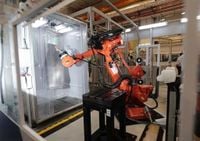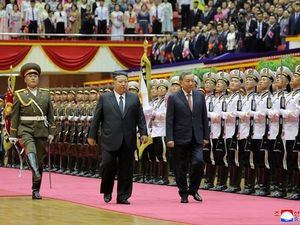Factory floors across Asia and the United States are humming with a blend of cautious optimism and persistent anxiety as new data for September 2025 reveal mixed signals in global manufacturing. While some regions are inching toward recovery, others remain mired in contraction, weighed down by trade tensions, tariffs, and shifting economic winds.
China, the world’s manufacturing powerhouse, offered glimmers of hope in September, even as its official manufacturing Purchasing Managers’ Index (PMI) remained in contraction territory for the sixth consecutive month. According to the National Bureau of Statistics, the PMI rose to 49.8, up from August’s 49.4, beating economist forecasts cited by The Wall Street Journal but still falling short of the 50-point mark that separates growth from decline. The improvement, though slight, was enough to catch the attention of regional analysts and global investors alike.
Delving into the numbers, the sub-index for factory production climbed to 51.9—a six-month high—while new orders improved to 49.7. Notably, new export orders also ticked up to 47.8 from 47.2, hinting at some resilience in external demand. Key growth sectors such as equipment and high-tech manufacturing continued to expand, with PMIs of 51.9 and 51.6, respectively. Business confidence seemed to be on the mend as well, with the expectations sub-index reaching 54.1, marking its third consecutive monthly increase.
Xu Tianchen, a senior economist at the Economist Intelligence Unit, told Reuters that the rebound reflects both a seasonal uptick and the impact of targeted government support. "China’s growth year-to-date has been supported by stronger-than-expected external demand, and this trend is likely to continue as a key driver for the remainder of the year," ING’s Lynn Song told The Wall Street Journal. Yet, Song and others warn that as the effects of fiscal stimulus begin to fade, growth could cool in the coming months.
Adding another layer to the analysis, a private sector survey by S&P Global, known as the RatingDog China General Manufacturing PMI, painted a rosier picture. This index, which focuses more on smaller, export-oriented firms, rose to 51.2 in September from 50.5 in August, indicating expansion. It also showed production and demand remained strong, with new export orders returning to growth for the first time since March. Still, deflationary pressures persist, as output prices continued to decline despite Beijing’s efforts to curb aggressive price cuts and ease deflation risks.
However, not all sectors are basking in the glow of improvement. The official non-manufacturing PMI, which covers services and construction, slipped to 50.0 in September—its weakest reading since November 2024. The services sub-index edged down to 50.1, while construction inched up slightly to 49.3. The waning of the summer travel boom left hospitality and entertainment particularly vulnerable, even as postal, telecommunications, and financial services stayed relatively strong.
China’s policymakers are now under pressure to chart a new course. The state planner announced it is considering a new policy instrument worth 500 billion yuan (about $70.2 billion) to replenish funding for local government investment projects. All eyes are on the upcoming Communist Party conclave, where leaders are expected to outline economic and social development goals for the next five years. Many analysts see this as a crucial juncture for China to pivot toward stronger domestic consumption and reduce its reliance on trade and investment.
Elsewhere in Asia, Singapore’s manufacturing sector managed to edge into expansion territory. The city-state’s overall factory activity PMI nudged up 0.1 point to 50.1 in September, according to local reports. The electronics sector, a key pillar of Singapore’s export economy, saw its PMI rise by 0.3 points to 50.7, indicating modest but welcome growth. This stands in contrast to the patchy performance seen elsewhere in the region, where some economies are still grappling with sluggish demand and global uncertainty.
Across the Pacific, the United States manufacturing sector showed slight improvement in September, but the recovery remains fragile. The Institute for Supply Management (ISM) released its monthly PMI, which rose 0.4 percentage points to 49.1%, up from 48.7% in August. This marks the seventh straight month of contraction, following a brief expansion earlier in the year. The new orders sub-index slipped to 48.9, while production climbed to 51%, suggesting that factories are producing more even as demand remains subdued.
Industry breakdowns reveal a deeply uneven landscape. Five manufacturing industries—petroleum and coal products, primary metals, textile mills, fabricated metal products, and miscellaneous manufacturing—expanded in September. However, eleven industries, led by paper products and wood products, continued to contract. Manufacturers cited severe business depression, increased price pressures due to tariffs (up to 20%), and capital projects on hold as they await greater economic certainty.
One transportation equipment manufacturer captured the mood in a comment to ISM: “Business continues to be severely depressed. Profits are down and extreme taxes (tariffs) are being shouldered by all companies in our space. We have increased price pressures both to our inputs and customer outputs as companies are starting to pass on tariffs via surcharges, raising prices up to 20 percent.”
Tariffs on steel, aluminum, and other imports have continued to disrupt supply chains and inflate costs, with ripple effects across sectors from chemicals to machinery to electronics. A respondent from the chemical products industry noted, “The tariffs are still causing issues with imported goods into the U.S. In addition to the cost concerns, product is being held up at borders due to documentation issues. The inflation issues continue; low volumes are a constant concern.”
Geopolitical tensions, weather disruptions, and policy uncertainty are also shaping the manufacturing landscape. The semiconductor industry, in particular, is feeling the pinch from high tariffs on parts from Korea, China, and Europe. “Our industry is at a low point right now as we race to get new nanotechnology in the U.S.,” a computer and electronic products manufacturer reported.
Against this backdrop, the Asian Development Bank has revised its 2025 growth forecast for developing Asia downward to 4.8 percent, citing the persistent drag from elevated U.S. tariffs and ongoing trade tensions. The bank’s move underscores the interconnectedness of global supply chains and the vulnerability of export-driven economies to shifts in policy and market sentiment.
As the world’s major manufacturing hubs grapple with these challenges, the coming months will test the resilience of global industry. Policymakers, business leaders, and workers alike are watching closely, hoping for clearer signals and steadier ground as 2025 draws to a close.






